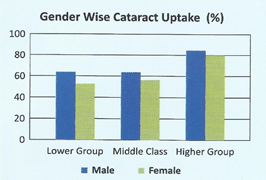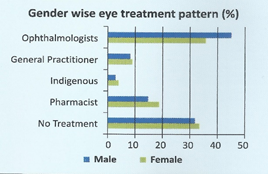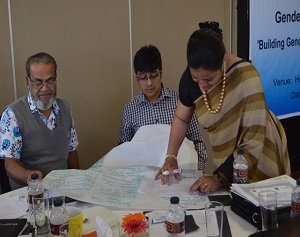Join a powerful, unprecedented alliance for better eye health for all.
Join IAPB-
Choose an alternate language here
The Fred Hollows Foundation Bangladesh, as part of the Seeing in Believing Phase V initiative, is implementing a four-year project titled ‘Building Gender Equitable Eye Health Systems in Barisal Division’ through Public Private Partnership. This year marked the completion of the first year of operation.
Knowledge Attitude & Practice (KAP) Survey
A KAP Survey was conducted earlier in the year following a mixed method approach, with a sample of 2,400 households, divided proportionately among all six districts of Barisal Division.
Consequently, a dissemination workshop was organized which was well attended by public and private sector partners, including representatives from National Institute of Ophthalmology & Hospital, Divisional Health Director of Barisal, district Civil Surgeons, Ophthalmologists and Management staff from partner hospitals, International Non-Governmental Organizations (INGOs) and representatives from Standard Chartered Bank. This workshop validated the KAP Survey findings, and saw impressive participant engagement.
Findings
 Particularly for women, there was a larger gap in knowledge not only about eye diseases, its causes, symptoms and cures, but also about available eye health services (availability, location, time and cost). Eye care needs of women are neglected, in many cases by women themselves.
Particularly for women, there was a larger gap in knowledge not only about eye diseases, its causes, symptoms and cures, but also about available eye health services (availability, location, time and cost). Eye care needs of women are neglected, in many cases by women themselves. Transportation within Barisal Division is very challenging and time consuming, as there are usually multiple riverways and roads to be crossed – Barisal being one of the world’s largest deltas with many rivers. In many cases, overnight stay is required, and women have to depend on their sons or husbands to accompany them for overnight stays.
Transportation within Barisal Division is very challenging and time consuming, as there are usually multiple riverways and roads to be crossed – Barisal being one of the world’s largest deltas with many rivers. In many cases, overnight stay is required, and women have to depend on their sons or husbands to accompany them for overnight stays.Gender Analysis
As per project plan, a Gender Analysis was undertaken based on the findings from the KAP Survey. Here, women’s demand and supply side constraints in accessing and utilizing eye care services in Barisal Division were identified.

In this workshop, participants were presented with the preliminary Gender Analysis. Participants took part in group activities to discuss a specific gender barrier, mitigation techniques, innovative gender strategies that may be implemented through the project, and specific communication messages for specific actors.
Subsequently, project staff, a Gender Consultant and the Creative team of the Social Communication Agency held workshops to develop a more detailed plan. Here, mitigation techniques were further broken down by tasks and local implementing organizations were identified.
Gender sensitive and focused communication messages, channel, media, activation type, timing, location and venue were identified for specific target groups. This plan was shared at an INGO Forum and drew much appreciation – it will be used by some of the INGOs to mainstream gender in their own project locations in Bangladesh.
Implementation of Innovative Gender Strategies
Based on the Gender Analysis, innovative strategies are already being implemented.
Future Plans
The next few years will see implementation of more innovative gender strategies that are being planned at the moment, based on the Gender Analysis, best practices and lessons learned.
The series of workshops and documents will form the basis of a Behaviour Change Communication (BCC) Strategy which is being developed for the project. The BCC Strategy will be a working document, and will be updated to include other innovative gender strategies, lessons learned, best practices, risks and challenges from time to time, during project period.

Program Coordinator,
The Fred Hollows Foundation, Bangladesh
[email protected]